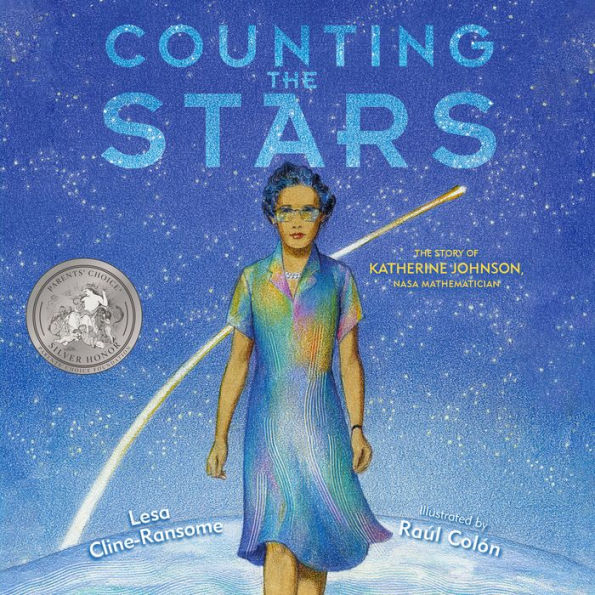The New York Times Book Review - Marjorie Ingall
With luminous watercolor, colored pencils, lithograph crayon and a scratch tool to create grooves and textures, [Colón] makes even file folders look gorgeous.
September 15, 2019 - Booklist
Katherine Johnson, one of the African American mathematicians featured in the movie Hidden Figures, gets a solid introduction in this picture book for older readers. Born in West Virginia to parents who highly prized education, Johnson was a math whiz who started high school at age 10. Her extraordinary skills and mentoring helped her to eventually get a job at Langley Aeronautical Laboratory. When the space-flight unit asked for a "computer," as the women were called, she became an integral part of the team calculating flight paths. John Glenn wouldn't go up for his groundbreaking flight until she ran the numbers—a check on mechanical computers. ...Colón's attractive illustrations, often with hints of colored prisms, reflect the book's tone with the emphasis on accomplishment. An author's note adds heft to this attractive introduction to Johnson's life.
Kirkus
Cline-Ransome (Finding Langston, 2018, etc.) traces Johnson's love of math, curiosity about the world, and studiousness from her early entry to school through her help sending a man into space as a human computer at NASA. .... Many biographies of black achievers during segregation focus on society's limits and the subject's determination to reach beyond them. This book takes a subtler approach, mentioning segregation only once (at her new work assignment, "she ignored the stares and the COLORED GIRLS signs on the bathroom door and the segregated cafeteria") and the glass ceiling for women twice in a factual tone as potential obstacles that did not stop Johnson. Her work is described in the context of the space race, which helps to clarify the importance of her role. Colón's signature soft, textured illustrations evoke the time period and Johnson's feeling of wonder about the world, expressed in the refrain, "Why? What? How?" ... A detail-rich picture book best for readers who enjoy nonfiction and are interested in history or science. (Picture book/biography. 9-12)
August 26, 2019 - Publishers Weekly
Cline-Ransome’s picture book biography pays tribute to African-American math prodigy Katherine Johnson, who soared past societal barriers to become one of NASA’s celebrated human computers. In long text blocks, the narrative underlines Johnson’s mathematical prowess and natural inquisitiveness (“Why? What? How?”), focusing on her early life (counting stars, skipping grades, earning a full college scholarship at 15), marriage and parenthood, and her career at Langley (early assignments, work amid the space race, persuading higher-ups that she should attend meetings) up through calculating the trajectory of astronaut John Glenn’s 1962 Earth orbit. Colón’s trademark illustrations, with their combed-through textures, set Johnson apart visually; her rainbow-hued dresses radiate alongside her white male colleagues’ white apparel. An author’s note concludes this handsomely illustrated book about a Hidden Figures standout. Ages 4–8. (Oct.)
September 15, 2019 - Booklist
Katherine Johnson, one of the African American mathematicians featured in the movie Hidden Figures, gets a solid introduction in this picture book for older readers. Born in West Virginia to parents who highly prized education, Johnson was a math whiz who started high school at age 10. Her extraordinary skills and mentoring helped her to eventually get a job at Langley Aeronautical Laboratory. When the space-flight unit asked for a "computer," as the women were called, she became an integral part of the team calculating flight paths. John Glenn wouldn't go up for his groundbreaking flight until she ran the numbers—a check on mechanical computers. ...Colón's attractive illustrations, often with hints of colored prisms, reflect the book's tone with the emphasis on accomplishment. An author's note adds heft to this attractive introduction to Johnson's life.
Kirkus Reviews
2019-07-14
This biography of renowned mathematician Katherine Johnson featuring illustrations by Colón aims for elementary-age readers.
Cline-Ransome (Finding Langston, 2018, etc.) traces Johnson's love of math, curiosity about the world, and studiousness from her early entry to school through her help sending a man into space as a human computer at NASA. The text is detailed and lengthy, between one and four paragraphs of fairly small text on each spread. Many biographies of black achievers during segregation focus on society's limits and the subject's determination to reach beyond them. This book takes a subtler approach, mentioning segregation only once (at her new work assignment, "she ignored the stares and the COLORED GIRLS signs on the bathroom door and the segregated cafeteria") and the glass ceiling for women twice in a factual tone as potential obstacles that did not stop Johnson. Her work is described in the context of the space race, which helps to clarify the importance of her role. Colón's signature soft, textured illustrations evoke the time period and Johnson's feeling of wonder about the world, expressed in the refrain, "Why? What? How?" The text moves slowly and demands a fairly high comprehension level (e.g., "it was the job of these women computers to double-check the engineers' data, develop complex equations, and analyze the numbers"). An author's note repeats much of the text, adding quotes from Johnson and more details about her more recent recognition.
A detail-rich picture book best for readers who enjoy nonfiction and are interested in history or science. (Picture book/biography. 9-12)




